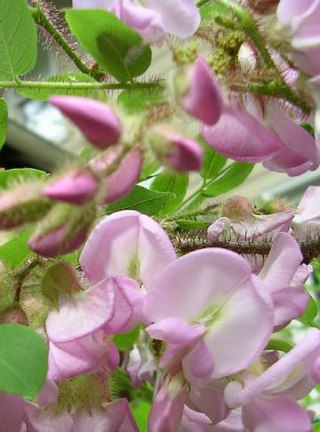
Robinia hispida, known as the bristly locust, rose-acacia, or moss locust, is a shrub in the subfamily Faboideae of the pea family Fabaceae. It is native to the southeastern United States, and it is present in other areas, including other regions of North America, as an introduced species. It is grown as an ornamental and can escape cultivation and grow in the wild.

Acalypha hispida, the chenille plant, is a flowering shrub which belongs to the family Euphorbiaceae, the subfamily Acalyphinae, and the genus Acalypha. Acalypha is the fourth largest genus of the family Euphorbiaceae, and contains many plants native to Hawaii and Oceania.

Angophora hispida grows as a mallee, or as a tree to about 7 m (25 ft) in height. A. hispida's small size, especially when compared to its Angophora and Eucalyptus relatives, leads to it being known by the common name dwarf apple. It is native to a relatively small patch of central New South Wales – from just south of Sydney up to the Gosford area. The plant's leaves are sessile (stalk-less) and hug the stem with heart-shaped bases. Its previous name – A. cordifolia – referred to these cordate leaves. Another distinctive feature are the red bristly hairs that cover the branchlets, flower bases and new growth. This leads to the specific epithet hispida.

Lastreopsis, known as shieldfern, is a genus of ferns in the family Dryopteridaceae, subfamily Elaphoglossoideae, in the Pteridophyte Phylogeny Group classification of 2016.
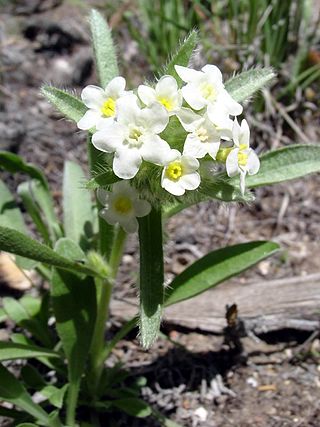
Greeneocharis circumscissa is a species of flowering plant in the borage family, known by the common name cushion cryptantha. It is native to western North America from Washington to Baja California to Colorado and it is also found in Argentina. It grows in sandy or gravelly types of habitat, from mountains to desert, below 9,500 m (31,200 ft) above sea level.

Todea barbara is known as the king fern. Occurring in moist areas of south eastern Australia, and also indigenous to New Zealand and South Africa.

Gleichenia dicarpa, commonly known as pouched coral fern or tangle fern, is a small fern of the family Gleicheniaceae found in eastern Australia, New Caledonia and New Zealand. It forms tangled thickets in wet places such as swamps and riverbanks.

Cheilanthes distans is a species of lip fern known by the common name bristly cloak fern. It has a woolly appearance with small white hairs on the top side of the fronds, and a rusty brown underneath.
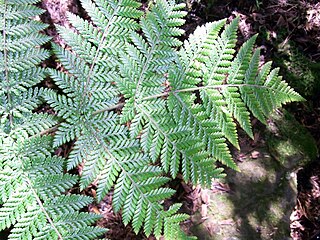
Lastreopsis silvestris, known as the mountain shield fern, is a rare plant found in eastern Australia. The habitat is high altitude rainforest on the McPherson Range, on the border of the states of New South Wales and Queensland. The habitat has high rainfall; mists and fogs are frequent. The original specimen was collected by Cyril Tenison White in December 1918, he described them as being “very abundant”.

Parapolystichum microsorum, synonym Lastreopsis microsora, known as the creeping shield fern is a common small plant found in eastern Australia and New Zealand. The habitat is rainforest or moist sheltered eucalyptus forests. It may form large colonies. The specific epithet microsora translates to "small sori".

Sarah Hirini is a New Zealand women's rugby union player and two-time Olympic medalist. She plays for the New Zealand women's national rugby sevens team, and captained the Manawatu Sevens side that took out the 2013 National Women's Sevens title in Queenstown. She was named in the squad for the 2017 Women's Rugby World Cup.

Smilax tamnoides, common name bristly greenbrier, is a North American species of plants native to the United States and Canada. It is widespread from Ontario and New York State south to Texas and Florida.
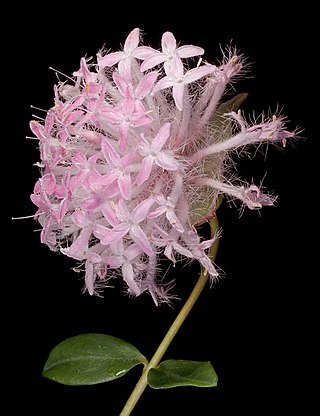
Pimelea hispida, commonly known as bristly pimelea, is a species of flowering plant in the family Thymelaeaceae and is endemic to the southwest of Western Australia. It is an erect shrub with elliptic leaves and erect clusters of pink flowers surrounded by 4 green involucral bracts.
Dicksonia lanata is a fern endemic to New Zealand. Colloquial names include stumpy tree fern, tūākura and tūōkura.
Maia Wilson is captain of the Robinhood stars since 2021.
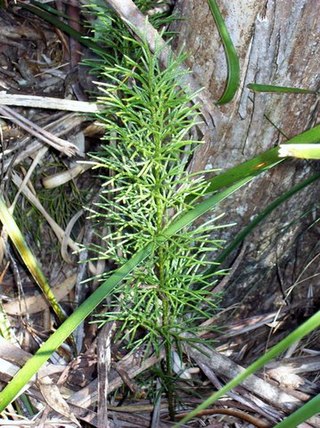
Pseudolycopodium is a genus of lycophyte in the family Lycopodiaceae with only one species, Pseudolycopodium densum, known as the bushy clubmoss. In the Pteridophyte Phylogeny Group classification of 2016, the genus is placed in the subfamily Lycopodioideae. Some sources do not recognize the genus, sinking it into Lycopodium. Pseudolycopodium densum is native to Australia, the North Island of New Zealand and New Caledonia. It is a spore-bearing vascular plant and grows up to a metre high. It is found in a wide variety of situations, often in high rainfall areas on sandy soils.

Dillwynia hispida , commonly known as red parrot-pea, is a species of flowering plant in the family Fabaceae and is endemic to south-eastern Australia. It is an erect shrub with more or less glabrous stems, linear to thread-like leaves and orange and red, partly crimson flowers.
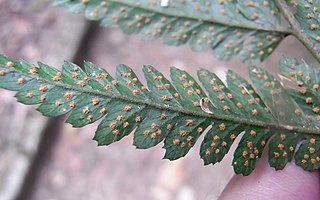
Lastreopsis marginans, known as the glossy or bordered shield fern is a fern found in eastern Australia. The habitat is rainforest or wet sclerophyll forest. Fronds are crowded and erect, between 50 and 90 cm long, coloured a glossy dark green. The lectotype was collected near the Clarence River by Hermann Beckler.

Parapolystichum munitum, synonym Lastreopsis munita, the naked shield fern is a plant found in tropical and subtropical forest areas in eastern Australia. Often seen in large colonies, near streams in rainforest and wet eucalyptus areas, north from the Barrington Tops.

















